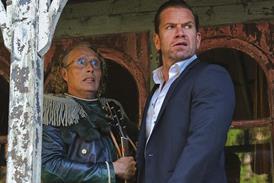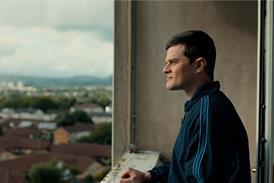Dir: Siegfried. France. 2003. 115mins
Sansa wants to be a profound and moving cinematic experience, perhaps something like a hyped-up tone poem. It is even called 'an essay' rather than a film. Toward that end, writer-director Siegfried employs every trick he can that is available in the panoply of the hand-held camera/berserk editing/rhythmically pounding music repertoire. (There may be more than 2,000 cuts in this film). Unfortunately, the result, rather than sublimity, is the complete exhaustion of the viewer over the course of the film's self-indulgent two-hour running time.
Its principal merit - and its downfall - is a relentless focus on the charismatic title character, a handsome young ne'er-do-well who plies his trade as one of the ubiquitous 'portrait' artists preying on tourists in Montmartre. Alas, the French police are not very sympathetic toward his artistic creativity and confiscate all his materials. Forced to leave the country in order to earn his living, he moves on to Spain, Italy, Russia, Japan, India, Morocco, Egypt and a host of other countries before returning to Paris. Not surprisingly, the police don't very much like him in any of these places either, nor do many of the men he runs into, and the result is lots of repetitive chase scenes in which the camera races to keep up with the action.
The figure of an elderly violinist and conductor named Mr Click (Gitlis) also passes through the film, giving it whatever modicum of narrative thrust it possesses. Either by accident or design - it is never made clear which - the multilingual Mr Click seems to be giving a concert in each of the cities that Sansa visits. Sansa and the violinist spend time with each other, wandering around and talking to girls, and we get to listen while Mr Click says wise, old-guy things.
Roschdy Zem is terrific in the underwritten title role, and the camera eats him up, almost literally, as it pirouettes, twists, zooms, and turns around him nearly non-stop for the entire running length of the film. But despite Zem's remarkable screen presence, the viewer, who is given no narrative thread to hang on to and only the skimpiest string of small titters to stay involved, eventually ceases to care. The fact that women everywhere throw themselves at this homeless person, even stalking him at points, also strains credulity. Some of Sansa's encounters (for example, with apparent revolutionaries in Russia) are surrealistically amusing, but these moments are scarce.
There is a hippy mentality here that may be welcome to the kind of viewers who like movies that militantly 'celebrate life' and one suspects that director Siegfried identifies strongly with Sansa as the victim of conventional rules that impede his artistic creativity.
The absolutely best moments of the film come when Siegfried lets his camera stream through the teeming streets of so many different countries. Using the kind of step-printing familiar from the films of Wong Kar-wai and others, Siegfried enchants us here with a blurred plethora of powerful and mysterious faces, especially near the end, in a darkening light, in India and Egypt.
Ultimately, however, without any information about these people, or their social conditions, other than what we can see on the surface, here too the viewer quickly tires.
Prod co: Vagabondages Arte France Mate Production
Int'l sales: Films Distribution
Prods: Julie Flament, Monsieur Otake, Zaouali, Jean Cazes, Violin Ivry Gitlis
Cinematography: Siegfried, Vincent Buron
Ed: Herve Schneid
Music: Sig
Cast: Roschdy Zem, Ivry Gitlis, Emma Suarez, Silke, Valentina Cervi, Rita Durao, Ayako Fujitani, Georges Abe, Bassem Samra, Amar Attia















![[Clockwise from top left]: Paul Thomas Anderson, Chloe Zhao, Ryan Coogler, Park Chan-wook](https://d1nslcd7m2225b.cloudfront.net/Pictures/274x183/9/0/0/1467900_writerdirectors_192733.jpg)


No comments yet